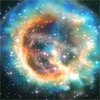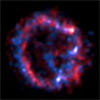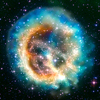CXC Home | Search | Help | Image Use Policy | Latest Images | Privacy | Accessibility | Glossary | Q&A
Tour of E0102-72.3
Quicktime MPEG
The supernova remnant known as E0102 was one of the targets that Chandra first observed after its launch in 1999. Now, some ten years later, new X-ray data from Chandra have been used to produce this spectacular image. E0102 is located about 190 thousand light-years away in the Small Magellanic Cloud, which is one of the nearest galaxies to the Milky Way. It was created when a star that was much more massive than the sun, exploded, an event that would have been visible from the southern hemisphere on Earth over one thousand years ago. The information captured in this new image, which includes optical data from the Hubble Space Telescope, reveals new clues about the geometry of the remnant. This in turn helps astronomers better understand the details of the explosion that created the remnant we see today.
[Runtime: 00:56]
Quicktime MPEG
The supernova remnant known as E0102 was one of the targets that Chandra first observed after its launch in 1999. Now, some ten years later, new X-ray data from Chandra have been used to produce this spectacular image. E0102 is located about 190 thousand light-years away in the Small Magellanic Cloud, which is one of the nearest galaxies to the Milky Way. It was created when a star that was much more massive than the sun, exploded, an event that would have been visible from the southern hemisphere on Earth over one thousand years ago. The information captured in this new image, which includes optical data from the Hubble Space Telescope, reveals new clues about the geometry of the remnant. This in turn helps astronomers better understand the details of the explosion that created the remnant we see today.
[Runtime: 00:56]
(Credit: X-ray (NASA/CXC/MIT/D.Dewey et al. & NASA/CXC/SAO/J.DePasquale); Optical (NASA/STScI))
Chandra X-ray Image and Animation of E0102-72.3
Quicktime MPEG
This motion graphic combines images of the supernova remnant E0102 with an animation of a three dimensional model for this object. It begins with the Chandra X-ray image of E0102, then dissolves to a so-called "velocity map" that shows material moving away from us (in red) and towards us (in blue). A cylinder-shaped model for E0102 is then shown, along with two smaller, faster moving regions. The model then dissolves back into the velocity map and the Chandra data.
[Runtime: 00:22]
Quicktime MPEG
This motion graphic combines images of the supernova remnant E0102 with an animation of a three dimensional model for this object. It begins with the Chandra X-ray image of E0102, then dissolves to a so-called "velocity map" that shows material moving away from us (in red) and towards us (in blue). A cylinder-shaped model for E0102 is then shown, along with two smaller, faster moving regions. The model then dissolves back into the velocity map and the Chandra data.
[Runtime: 00:22]
(Credit: NASA/STScI/G.Bacon; X-ray: NASA/CXC/MIT/D.Dewey et al. & NASA/CXC/SAO/J.DePasquale)
X-ray and Optical Images of E0102
Quicktime MPEG
The supernova remnant known as E0102 was one of the early objects Chandra observed after its launch on July 23, 1999. Now, nearly ten years later, new Chandra data has been used, along with data from the Hubble Space Telescope, to create this stunning new image. Located in the Small Magellenic Cloud, E0102 is about 190,000 light years from Earth. E0102 was created when a star much more massive than our Sun exploded, an event that would have been visible from the Southern Hemisphere of the Earth over 1,000 years ago.
[Runtime: 00:14]
Quicktime MPEG
The supernova remnant known as E0102 was one of the early objects Chandra observed after its launch on July 23, 1999. Now, nearly ten years later, new Chandra data has been used, along with data from the Hubble Space Telescope, to create this stunning new image. Located in the Small Magellenic Cloud, E0102 is about 190,000 light years from Earth. E0102 was created when a star much more massive than our Sun exploded, an event that would have been visible from the Southern Hemisphere of the Earth over 1,000 years ago.
[Runtime: 00:14]
(Credit: X-ray (NASA/CXC/MIT/D.Dewey et al. & NASA/CXC/SAO/J.DePasquale); Optical (NASA/STScI)
Return to E0102-72.3 (July 22, 2009)





